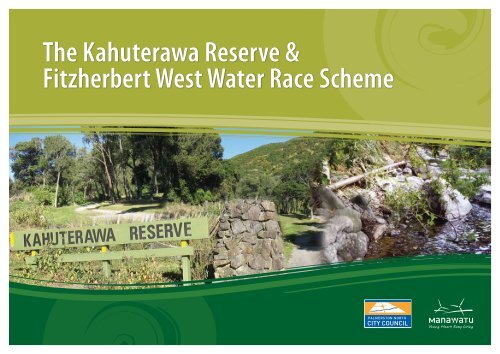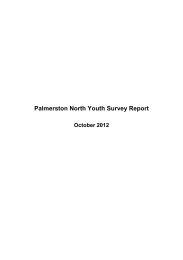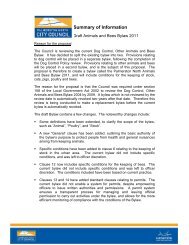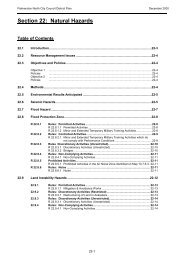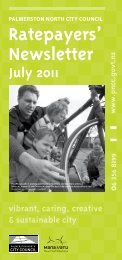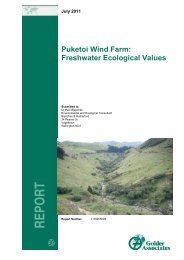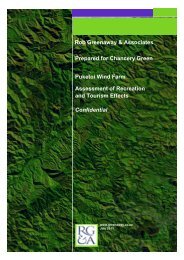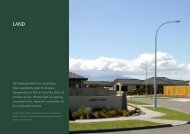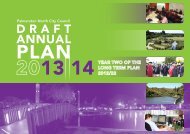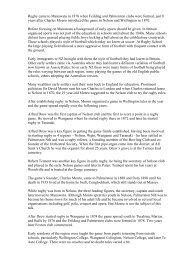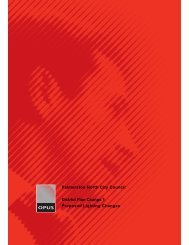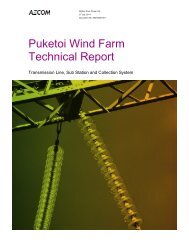The Kahuterawa Reserve & Fitzherbert West Water Race Scheme
The Kahuterawa Reserve & Fitzherbert West Water Race Scheme
The Kahuterawa Reserve & Fitzherbert West Water Race Scheme
You also want an ePaper? Increase the reach of your titles
YUMPU automatically turns print PDFs into web optimized ePapers that Google loves.
<strong>The</strong> <strong>Kahuterawa</strong> <strong>Reserve</strong> &<strong>Fitzherbert</strong> <strong>West</strong> <strong>Water</strong> <strong>Race</strong> <strong>Scheme</strong>Part One: Goals and Actions 1
<strong>The</strong> <strong>Kahuterawa</strong> <strong>Reserve</strong> & <strong>Fitzherbert</strong> <strong>West</strong> <strong>Water</strong> <strong>Race</strong> <strong>Scheme</strong><strong>The</strong> <strong>Kahuterawa</strong> <strong>Reserve</strong> and the <strong>Fitzherbert</strong> <strong>West</strong> <strong>Water</strong> <strong>Race</strong> <strong>Scheme</strong>From Palmerston North<strong>The</strong> <strong>Kahuterawa</strong> <strong>Reserve</strong> 1 (the <strong>Reserve</strong>) was created in 1969 with the addition of 8½ acres (3.44 hectares) of land owned by the Satherley family.Kairanga County Council records show a resolution to pay £120 per acre ($4,295per hectare in 2008 dollars 2 ), however there is no record of any payment everbeing made. <strong>The</strong> Satherleys note that the land was donated to Council.<strong>Kahuterawa</strong> <strong>Reserve</strong><strong>The</strong> <strong>Reserve</strong> contains remnants of the <strong>Fitzherbert</strong> <strong>West</strong> <strong>Water</strong> <strong>Race</strong> <strong>Scheme</strong>.<strong>The</strong> <strong>Reserve</strong> was a successful project between the Kairanga County Council (theCouncil), the Satherleys and the Manawatu Lions Club.<strong>Reserve</strong> development was a large project for the Lions Group, over three years. <strong>The</strong>toilet block was constructed by Lyn Christensen and the Council carted boulders.Over the weekends the Lions plastered and assembled the boulder walls. Treeswere planted on the land on the western side of the river by the Council.In July 1970 the Council officially called the reserve “<strong>Kahuterawa</strong> Park”. To many itwas called the Lions Park due to the large amount of work the Lions had putinto it.Intake to water schemeWhen local government reorganisation took place in 1989 the Palmerston NorthCity Council (PNCC) took over the <strong>Reserve</strong>. PNCC added 0.39 hectares (Lot 4 DP80726) in 1997.To Back & Sledge Tracks1 <strong>The</strong> <strong>Kahuterawa</strong> <strong>Reserve</strong> was originally called the <strong>Kahuterawa</strong> Park by the Kairanga CountyCouncil. Under the Palmerston North City Council’s management it is known as the <strong>Kahuterawa</strong> <strong>Reserve</strong>.2 Conversions to 2008 dollars were done using the <strong>Reserve</strong> Bank online inflation calculator.Part One: Goals and Actions 3
Manawatu RiverLintonMilitaryCampApproximate areasupplied by<strong>Water</strong> <strong>Scheme</strong><strong>Kahuterawa</strong>StreamAfter you have completed your picnic or barbecue you may have gone for awalk up the stream and found those old rusty four inch (10cm) pipes laying inthe water or on the bank and wondered what they had belonged to. <strong>The</strong>y werepart of the original <strong>Fitzherbert</strong> <strong>West</strong> <strong>Water</strong> <strong>Race</strong> <strong>Scheme</strong>, planned from 1914, andbuilt in 1917. Several entry pipes took water from the stream to flow down into asettlement box to take out the silt and debris.From the early 1900s there had been a need for some kind of water supply inthe <strong>Fitzherbert</strong> <strong>West</strong> area. <strong>The</strong>re were no permanent streams and the shallowcreek beds dried up in the summer. When tank water ran out, water for housesand cowsheds had to be carted in milk cans from a reliable source such as the<strong>Kahuterawa</strong> Stream or Manawatu River.<strong>The</strong> 25 feet (7.6 metres) wells in the area had a tendency to fail when they weremost needed in the summer or worse still in a drought. In later years reliable waterwas found at a depth of about 260 feet (79.2 metres), but wells this deep weren’tpossible in those days.In dry conditions farmers had to take their stock to the Manawatu River or the<strong>Kahuterawa</strong> Stream. This job could take 3 to 4 hours out of a working day.<strong>Kahuterawa</strong><strong>Reserve</strong><strong>The</strong> area needing the water was bounded by Camp Road – Hewitts Road -Whitmore Road - Eyre Road and the Main Road, then down towards theManawatu River, a total of about 2,500 acres (1,012 hectares).<strong>The</strong> <strong>Kahuterawa</strong> Stream had long been considered for some kind of water scheme.Farmers could see all that water flowing under the main road bridge, all the yearround, and wondered if they could bring water down in an open water race. Thishad worked in many parts of New Zealand, but the <strong>Kahuterawa</strong> Valley terrainrequired several aqueducts around bluffs and somehow pumping up into tanks, ata time long before electricity came to the area.4<strong>Kahuterawa</strong> Outdoor Recreation Plan
Another idea was to install a hydraulic ram in the <strong>Kahuterawa</strong> Stream. <strong>The</strong>yoperated continuously and the valve would be heard clanking away at a distanceon a clear night. <strong>The</strong>y did not require electricity but were inadequate for theamount of water required.<strong>Water</strong> <strong>Scheme</strong> PipeIn July 1916 Councillors Craw and Moody led a deputation from Ravenswood (nearWhitmore Road) to the Kairanga County Council (the Council) to see if the <strong>Water</strong>Supply Act 1908 (the Act) could be used to finance a water scheme. It was decidedfurther legal advice was needed.Another deputation in October 1916 questioned whether a special loan could beobtained. It was decided that an engineer should be engaged to discuss all theoptions. Mr R Edwards, a Palmerston North engineer, was appointed.<strong>The</strong> scheme Mr Edwards developed was gravity feed needing no reservoir. <strong>The</strong>water would be conveyed from is intake point, on the Boundary of lots 329 and330 of the Arawaru Survey District (at the <strong>Kahuterawa</strong> <strong>Reserve</strong>), by pipes to thefarms. Any surplus water was to flow into several dried up water courses. <strong>The</strong>system would be 4 ½ miles (7 ½ km) long, with a fall in height of 250 feet (80 m).<strong>The</strong> main pipe line was to be 4 inch (10cm) cast iron and follow the <strong>Kahuterawa</strong>Stream, crossing three times, then climbing out of the Valley, and cuttingdiagonally across towards the top of Whitmore Road, supplying some farms onthe way.One of theseveralwater intakestructuresMr Loughnan of Loughnan & Jacobs , Solicitors for the Council, advised inNovember 1916 (with a considerable amount of legal jargon), that the Councilwould need to declare, by special order, the <strong>Fitzherbert</strong> <strong>West</strong> <strong>Water</strong> <strong>Race</strong> <strong>Scheme</strong>a water supply district. It could then apply for a loan under the Act and set upa committee of water rates payers to manage the <strong>Water</strong> <strong>Scheme</strong> on behalf ofthe Council. This would allow the Council the right to levy a rate over the <strong>Water</strong><strong>Scheme</strong> area, to service the debt, and repay the loan. Mr Loughnan stated he wasnot an engineer but thought that Mr Edwards scheme should be adequate forstock and domestic purposes for the people of the <strong>Fitzherbert</strong> <strong>West</strong>.Part One: Goals and Actions 5
A deputation led by Mr Arthur Smith in January 1917 supported Mr Edwardsscheme.In August 1917 the Council resolved to apply for a Special Loan from the StateAdvances Corporation. Mr Sladden was to be the engineer for the <strong>Water</strong> <strong>Scheme</strong>,but later in 1918 he was called away on defence duties. World War I was inprogress! Mr Edwards was again given the job.<strong>The</strong> rate on all the lands using the <strong>Water</strong> <strong>Scheme</strong> was 1 ¾ pence in the pound onthe unimproved value of the property (0.7%). <strong>The</strong> first loan was for 5,000 pounds($560,000 in 2008 terms). Work started in August 1918, another loan for 2,000pounds ($224,000 in 2008 dollars) was raised. A final loan in August 1920 of 1,200pounds ($134,000 in 2008 dollars) was secured. <strong>The</strong> total cost, from records, was8,200 pounds ($917,000 in 2008 dollars). However this cost excluded most of themajor work of clearing a path and digging a drain, which was done by the farmers.We can only imagine what the value of that work would have been today!<strong>The</strong> photo above, dated November 1921, shows a lot volunteers working on reinstalling two chains (40m)of pipe after a flood.<strong>The</strong> first <strong>Fitzherbert</strong> <strong>West</strong> <strong>Water</strong> <strong>Race</strong> Committee (the Committee), to reportmonthly to the Council, was:- H.J. Lauridsen (Chairman) - T.H. Gretten,- I. Croad, - W.J. Harris, and- J.J.P. Lynch, and - Arthur Smith.<strong>The</strong> pipe itself was made in Australia and due to its length was hard to handle.Each piece had a collar on one end, with the next piece of pipe having to befitted in and sealed with lead to stop leaking. <strong>The</strong> pipe could be smashed with themovement of large boulders in the stream.Some charges over and above the land rates were made.Ravenswood Dairy Factory, near Whitmore Road, paid 12 pounds ($1,342 in 2008dollars) annually.6<strong>Kahuterawa</strong> Outdoor Recreation Plan
<strong>The</strong> Council paid 25 pounds ($2,796 in 2008 dollars) for a water trough at Kendellsand Main Road corner, and 3 pounds ($336 in 2008 dollars) annually for water forthe drovers moving large mobs of cattle through the district.In later years the <strong>Fitzherbert</strong> Lions Club restored the old water trough and the lastwater pump that had been located at Hewitts Road. Both have become historicalsites.<strong>The</strong> Committee and volunteers kept the old pipe flowing for 35 years, till 1955,when an electric pump was installed at the top of Hewitts Road. <strong>The</strong> old pipesweren’t trouble free, silting and flooding were always problems. <strong>The</strong> electric pumpremoved the most troublesome part of the old pipe leaving only the sectionthrough to Whitmore Road. In 1963 the remains of the cast iron pipe to WhitmoreRoad were replaced with a new fibrolite pipe.A second larger pump was installed in 1978 and used until the Palmerston NorthCity Council took over. A chlorination unit was installed and the scheme wasconverted to get its water from the Turitea Dam in 1990. This gave a guaranteedpressure and cost of $450,000 ($689,000 in 2008). <strong>The</strong> old piping was slowlyreplaced with PVC or polythene to avoid corrosion.<strong>The</strong> photo above, shows the Historic Anderson 1700 <strong>Water</strong> Pump.I have researched these few paragraphs to explain the early history of the<strong>Fitzherbert</strong> <strong>West</strong> <strong>Water</strong> <strong>Race</strong> <strong>Scheme</strong> and its history in relation to the <strong>Kahuterawa</strong>Valley. This <strong>Water</strong> <strong>Scheme</strong> was a fascinating achievement, planned andimplemented in the midst of World War I. I hope this will bring new interest tothe Valley as we move on with the development of the <strong>Kahuterawa</strong> OutdoorRecreational Plan.Ian H. ArglyePalmerston North City Council thanks Mr Arglye for his dedicated research andallowing us to use his work in Council publications.Part One: Goals and Actions 7


